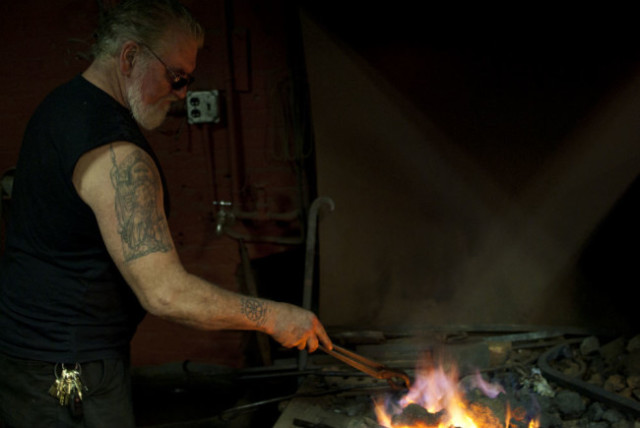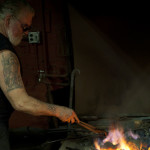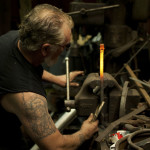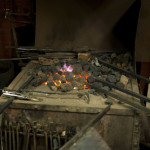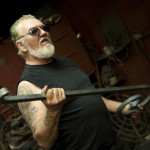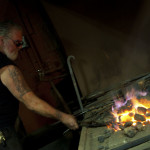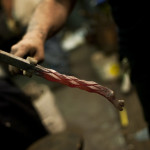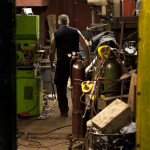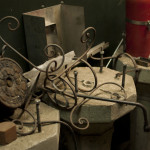*Originally published on The Airship
Larry Hagberg looks like a guy who hammers steel for a living. He’s tall with large tattooed arms and a barrel chest. His hair and beard are silver, his hands black with soot. He’s a throwback to a forgone era of ruggedness, not just the kind of guy who has a workshop but one who tightens bolts by hand. He was bending scrolls for the fence at Peter Detmold Park in Midtown when I visited his workshop.
“Rather than just put a straight piece of iron,” he said. “It’s a nice street, so I figured I’d make something like this, so when you look at the fence it doesn’t look like a bunch of iron bars.”
Born in Bushwick, Brooklyn and raised in Ozone Park, Queens, Hagberg started metal working in 1976. As a teenager, he worked at the the Broken Wheel Ranch in Round Top, a small upstate town near Cairo, New York, where he was first introduced to horseshoeing. He joined the City’s Parks Department in 1984 and has spent the last 30 years “heating and beating” metal into fences, gates and locks for use throughout the city. Some of his favorite pieces include a lock and key for an old lamp post in Union Square and a gate on Central Park’s Arsenal.
Today, the parks department’s forge continues burning in the middle of Central Park, near 86th Street, in a century-old stable building. At its height, the workshop housed five blacksmiths and four “helpers,” though today they’re down to just three smiths. It smells of burning coal and is packed with metal scraps that will one day be reshaped or melted down.
I visited Hagberg at his workshop to learn more about his craft and where blacksmithing fits into modern life in New York City. At 61 years old, he’s still animated and jovial, with a laugh as big an anvil, and always ready to impart his knowledge on the uninitiated, filtering his anecdotes through a throaty Brooklyn brogue.
How did you get started?
I was a horse-shoer. I worked on a ranch when I was a kid up until I was 16. I got to know the guy who used to shoe the horses. I liked horses, and that was a job where you could be around horses. So when I came back here after a couple of years passed, I hooked up with the guy who was shoeing the horses for the carriage stables. … I worked with him for a year or two, then I went to horseshoeing school and became a farrier. Then this job came up. There used to be a city-wide test. All the agencies had blacksmiths at the time. Now the Fire Department, DOT, Parks and Sanitation still have blacksmiths. There was a written test, and if you passed that, you’d take a practical test which you had to forge a chisel and make a ring to a specific size. This is a dream job for blacksmiths.
How so?
Have you ever been to Hansborough pool? They were going to put roll down gates in front of the computer room, so the deputy chief of operations says, “ask if he wants to make a pair of gates.” So I made these two nice gates, 11 feet. I made the lock and key, like an old jail key. It came out beautiful. I love that thing.
What drew you to metal work?
I don’t know, I got an artistic side. I got drawn in, there was nothing I could do about it.
Are people surprised when you tell them what you do?
It’s surprising that I’m a blacksmith in 2013 in the middle of Central Park. People are surprised sometimes because it’s a dying craft. In the mid ‘60s, it was almost dead. There was very few blacksmiths at the end of the ‘50s, early ‘60s, so the ones that were still working taught younger people, and I think in the early ‘70s they formed the Artists Blacksmith Association of North America. It had a big resurgence, especially now when everything is made out of the country. When you have something that’s hand made, it’s an heirloom. It’s not just something you buy from China and throw away when you move.
How is your stuff better?
Usually if a blacksmith makes it, it’s going to be stronger. When you look at it, it’s something you want to touch. You want to feel it. For years the blacksmith tried to do work that looked like it came from the factory, [he laughs] and now these days people don’t want that. They want to see hammer marks, even though you have the skill to not leave the marks. Look at that, [pointing at the rod in the fire] normally you would see that made out of tubing, but that’s solid. You can tell the difference, all you have to do is hold it, look at it. When we make stuff, look how we make it, like they did hundreds of years ago.
Has the craft changed much in that time?
The methods, no. The principles are the same — heat, bend, stretch, upset. I’m still doing it like 3,000 years ago. Well, I’m not using a goatskin, but I still got the anvil. They haven’t improved on that yet.
What’s the role of the blacksmith today?
I have a piece of fence there that’s over a hundred years old. Who’s going to fix that? Only a blacksmith. You can get a welder that can make something that’ll look pretty good, but it won’t be the same. That thing has mortise and tenons, it’s not welded together in any way. They brought in a cannon caisson from the Revolutionary War, and after we fixed it, the guy that brought it in didn’t know where it was fixed.
If [the parks department] goes on the outside to get a job done, and they send guys out that they hire, its going to cost twice as much. It works out cheaper because we have no equipment, we do it the old way. … You need a new punch machine, its going to cost $30,000 to $40,000 — that’s a half a year’s pay. But you got some guy knows how to do it, you got $200 worth of coal, $50 worth of iron, you can do a $5,000 job.
So why was [the blacksmith craft] dying?
It was dying because blacksmiths did their jobs so well they put themselves out of business. Every blacksmith who needed to do something faster had to figure out a better way. He’d think his way into a machine to do it, like a power hammer. That was an extra man that didn’t cost anything. Then the modern punch press, punching holes faster, because back then you had to heat them up in the forge and punch them with somebody holding the tool and you striking the hammer. With a punch machine, anybody could do it.
What do you think the future of the craft looks like?
That depends on the clientele — that’s what’ll either make it or break it. Otherwise it’s just going to be a bunch of hobby guys. There’s so much knowledge lost over the years that we’re reinventing it. Everybody thinks they’re so smart because they invented something, but then if you look and you research back, you see some guy did that in the 1700s.
How hot do pieces in the fire get?
The forge will get above the melting temperature. We melted aluminum and made castings. They had a fence downtown that was a hundred years old, and the pieces were missing off the top. They were cast iron, so we brought one back here, made a mold. We had the old swings — we were switching from aluminum to the plastic pieces of crap we have now — so we melted the swings down and made the finials for the fence along Stuyvesant Park.
What are some other things you made?
A go-kart. They were having the Street Games and wanted a soapbox derby. You see that pile of stuff there, that’s not scrap, that’s potential jobs — so everything came from the junk pile. The painter painted it green, with yellow and orange flames and the parks logo on top. We used something weird for the brakes; it might have been a playground mat.
Do you have a shop at home?
I’m in the process of building one. Making the building is a nightmare. [Laughs.]
It’s like a shack in your yard?
Shack?! What am I, gonna work in a shack?!
How would somebody young go about becoming a blacksmith?
Like I was saying, with the resurgence, people just go to classes. If the bug bites you, you’ll really go after it. I’m really shocked how many people want to know. Sometimes I overestimate what I think they should already know: how to hold a hammer, how to hit it — hit ‘til it’s flat! You got to let the metal know you’re hitting it. You’re not massaging it. Hit the damn thing!
What about the physical toll after so many years?
If you use proper technique, you just get tired like anything else. You develop different muscles doing different things. I tried to chop a tree down two weeks ago; for like three days, I couldn’t stand straight, but I could still swing a 16-pound sledgehammer. I think it’s the muscles and angles you use them at, you get used to certain movements, muscle memory. In the old days, when we got tired and couldn’t hold the hammer anymore, we would duct tape it to our hand and just keep working.
So you can be a really old blacksmith?
Yeah, if you’re smart about it. I saw a video on Youtube, a guy 84 years old.
Hence the home shop.
My wife thought I was gonna be a gardener when I retired. I heard about so many guys who retire, especially when you do a hard job, you can’t just move to Florida and live on a golf course. You’re a working guy, that stuff’ll kill you. All of a sudden you stop doing what you’re doing and it all veers to the right and downhill.
